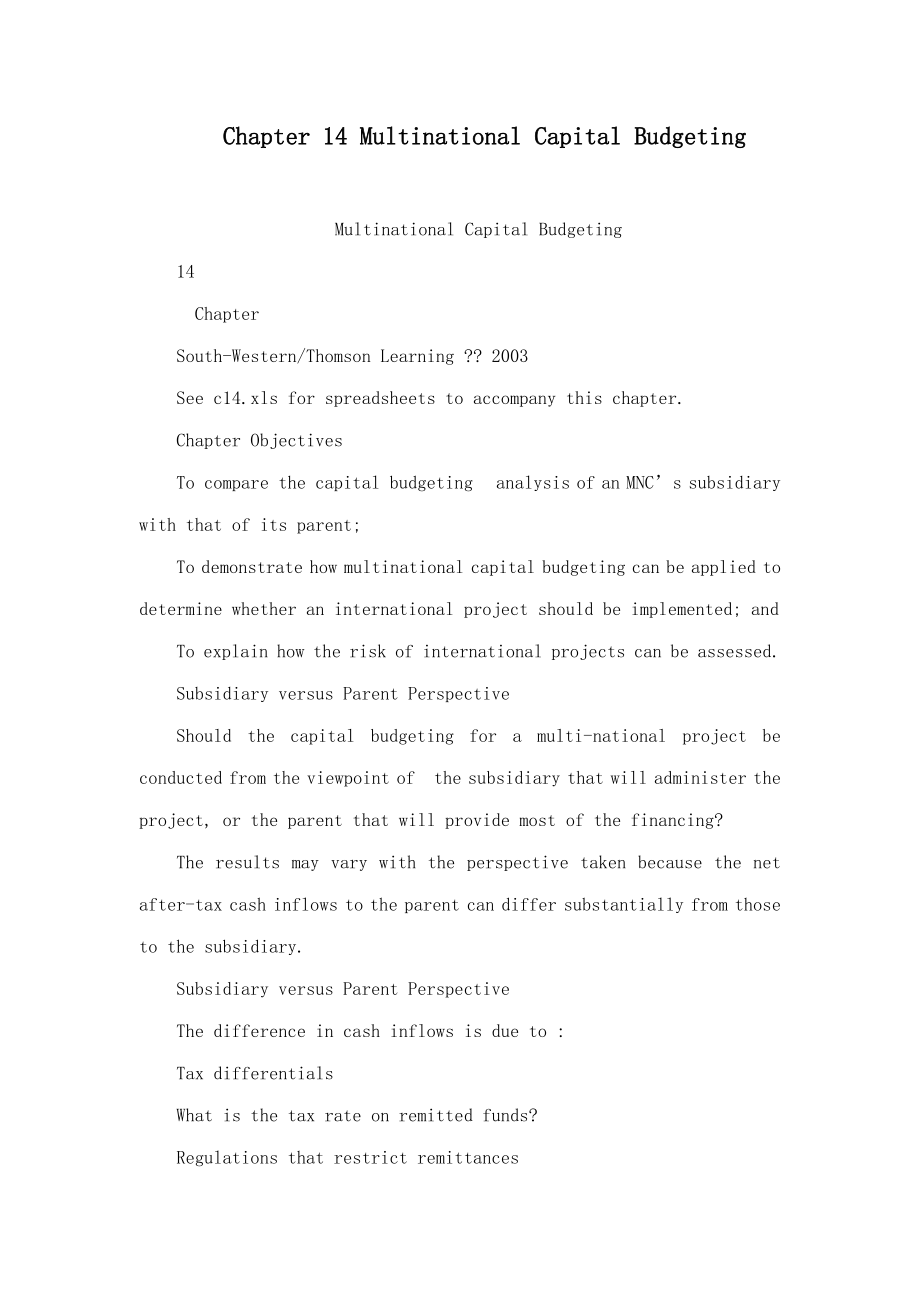 ChapterMultinationalCapitalBudgeting
ChapterMultinationalCapitalBudgeting



《ChapterMultinationalCapitalBudgeting》由会员分享,可在线阅读,更多相关《ChapterMultinationalCapitalBudgeting(8页珍藏版)》请在装配图网上搜索。
1、Chapter 14 Multinational Capital BudgetingMultinational Capital Budgeting14 ChapterSouth-Western/Thomson Learning ? 2003See c14.xls for spreadsheets to accompany this chapter.Chapter ObjectivesTo compare the capital budgeting analysis of an MNCs subsidiary with that of its parent;To demonstrate how
2、multinational capital budgeting can be applied to determine whether an international project should be implemented; andTo explain how the risk of international projects can be assessed.Subsidiary versus Parent PerspectiveShould the capital budgeting for a multi-national project be conducted from the
3、 viewpoint of the subsidiary that will administer the project, or the parent that will provide most of the financing?The results may vary with the perspective taken because the net after-tax cash inflows to the parent can differ substantially from those to the subsidiary.Subsidiary versus Parent Per
4、spectiveThe difference in cash inflows is due to : Tax differentialsWhat is the tax rate on remitted funds?Regulations that restrict remittancesExcessive remittancesThe parent may charge its subsidiary very high administrative fees.Exchange rate movementsOnline ApplicationFor country-specific inform
5、ation such as general business rules, regulations and tax rates, visit:the Price Waterhouse Coopers site at /.pwcglobal4,/.us.kpmg/microsite/Global_Tax/CTR_Survey/index.htmlthe Yahoo! International Finance Center at /biz.yahoo/ifc/.Remitting Subsidiary Earnings to the ParentAfter-Tax Cash Flows Remi
6、tted by SubsidiaryCash Flows Generated by SubsidiaryAfter-Tax Cash Flows to SubsidiaryCash Flows Remitted by SubsidiaryWithholding Tax Paid to Host GovernmentRetained Earningsby SubsidiaryCorporate Taxes Paid to Host GovernmentConversion of Fundsto Parents CurrencyParentCash Flows to ParentSubsidiar
7、y versus Parent PerspectiveA parents perspective is appropriate when evaluating a project, since any project that can create a positive net present value for the parent should enhance the firms value.However, one exception to this rule may occur when the foreign subsidiary is not wholly owned by the
8、 parent.Input for MultinationalCapital BudgetingThe following forecasts are usually required:1.Initial investment2.Consumer demand3.Product price4.Variable cost5.Fixed cost6.Project lifetime7.Salvage (liquidation) valueInput for MultinationalCapital Budgeting9.Tax laws10.Exchange rates11.Required ra
9、te of returnThe following forecasts are usually required:8.Fund-transfer restrictionsOnline ApplicationWhat is the expected economic growth rate for a particular country? Consult the Country Commercial Guides prepared by embassy staff at /.usatrade.gov/website/ccg.nsf/ccghomepage?openform.Refer to t
10、he CIAs World Factbook at /.odci.gov/.MultinationalCapital BudgetingCapital budgeting is necessary for all long-term projects that deserve consideration. One common method of performing the analysis is to estimate the cash flows and salvage value to be received by the parent, and compute the net pre
11、sent value (NPV) of the project.MultinationalCapital BudgetingNPV= initial outlay n+ S cash flow in period t t =1 (1 + k )t+ salvage value (1 + k )nk = the required rate of return on the projectn = project lifetime in terms of periodsIf NPV > 0, the project can be accepted.Capital Budgeting Analy
12、sis Period t1.Demand(1)2.Price per unit(2)3.Total revenue(1)?(2)=(3)4.Variable cost per unit(4)5.Total variable cost (1)?(4)=(5)6.Annual lease expense(6)7.Other fixed periodic expenses(7)8.Noncash expense (depreciation)(8)9.Total expenses(5)+(6)+(7)+(8)=(9)10.Before-tax earnings of subsidiary(3)(9)=
13、(10)11.Host government taxtax rate?(10)=(11)12.After-tax earnings of subsidiary(10)(11)=(12)Capital Budgeting Analysis Period t13.Net cash flow to subsidiary (12)+(8)=(13)14.Remittance to parent(14)15.Tax on remitted fundstax rate?(14)=(15)16.Remittance after withheld tax(14)(15)=(16)17.Salvage valu
14、e(17)18.Exchange rate(18)19.Cash flow to parent(16)?(18)+(17)?(18)=(19)20.Investment by parent(20)21.Net cash flow to parent(19)(20)=(21)22.PV of net cash flow to parent(1+k) - t?(21)=(22)23.Cumulative NPV?PVs=(23)Factors to Consider in Multinational Capital BudgetingExchange rate fluctuations. Diff
15、erent scenarios should be considered together with their probability of occurrence.Inflation. Although price/cost forecasting implicitly considers inflation, inflation can be quite volatile from year to year for some countries.Factors to Consider in Multinational Capital BudgetingFinancing arrangeme
16、nt. Financing costs are usually captured by the discount rate. However, many foreign projects are partially financed by foreign subsidiaries. Blocked funds. Some countries may require that the earnings be reinvested locally for a certain period of time before they can be remitted to the parent.Facto
17、rs to Consider in Multinational Capital BudgetingUncertain salvage value. The salvage value typically has a significant impact on the projects NPV, and the MNC may want to compute the break-even salvage value.Impact of project on prevailing cash flows. The new investment may compete with the existin
18、g business for the same customers.Host government incentives. These should also be considered in the analysis.Adjusting Project Assessmentfor RiskIf an MNC is unsure of the cash flows of a proposed project, it needs to adjust its assessment for this risk.One method is to use a risk-adjusted discount
19、 rate. The greater the uncertainty, the larger the discount rate that is applied.Many computer software packages are also available to perform sensitivity analysis and simulation.Impact of Multinational Capital Budgetingon an MNCs ValueE (CFj,t )=expected cash flows in currency j to be received by t
20、he U.S. parent at the end of period tE (ERj,t )=expected exchange rate at which currency j can be converted to dollars at the end of period tk=weighted average cost of capital of the parentMultinational Capital Budgeting DecisionsChapter ReviewSubsidiary versus Parent PerspectiveTax DifferentialsRes
21、tricted RemittancesExcessive RemittancesExchange Rate MovementsInput for Multinational Capital BudgetingMultinational Capital BudgetingChapter ReviewFactors to Consider in Multinational Capital BudgetingExchange Rate FluctuationsInflationFinancing ArrangementBlocked FundsUncertain Salvage ValueImpact of Project on Prevailing Cash FlowsHost Government IncentivesChapter ReviewAdjusting Project Assessment for RiskRisk-Adjusted Discount RateSensitivity AnalysisSimulationImpact of Multinational Capital Budgeting on an MNCs Value
- 温馨提示:
1: 本站所有资源如无特殊说明,都需要本地电脑安装OFFICE2007和PDF阅读器。图纸软件为CAD,CAXA,PROE,UG,SolidWorks等.压缩文件请下载最新的WinRAR软件解压。
2: 本站的文档不包含任何第三方提供的附件图纸等,如果需要附件,请联系上传者。文件的所有权益归上传用户所有。
3.本站RAR压缩包中若带图纸,网页内容里面会有图纸预览,若没有图纸预览就没有图纸。
4. 未经权益所有人同意不得将文件中的内容挪作商业或盈利用途。
5. 装配图网仅提供信息存储空间,仅对用户上传内容的表现方式做保护处理,对用户上传分享的文档内容本身不做任何修改或编辑,并不能对任何下载内容负责。
6. 下载文件中如有侵权或不适当内容,请与我们联系,我们立即纠正。
7. 本站不保证下载资源的准确性、安全性和完整性, 同时也不承担用户因使用这些下载资源对自己和他人造成任何形式的伤害或损失。
